I got very excited a few years ago sneaking quietly along the grassy bank of a clear flowing New Zealand stream watching 2kg brown trout swimming up and down in search of a hapless insect breast-stroking along the surface.
It looked like it would be great fun to cast at, and then it suddenly dawned on me why so many people around the world spend countless hours chasing freshwater trout on fly. That prompted me to ponder how ordinary our freshwater fishery is in Queensland in comparison – discounting the impoundment barra fishery.
But how wrong I was! It is so easy to overlook what is right under one’s nose.
I had conveniently forgotten a wonderful day I’d spent wading up Jarrah Creek behind Tully in North Queensland. We spent days casting small lures to hot-headed sooty grunter and fruitless hours searching for jungle perch. I’d also caught cart-wheeling saratoga in the pristine waters of the Jardine River near the tip of Cape York Peninsular way back in 1980.
I guess it is just that these exciting freshwater fishing experiences are a long way from Yeppoon in Central Queensland where I live, or are they?
Just as prophets are seldom recognised in their own town, so it is that we tend to overlook opportunities at the bottom of our garden. It’s reasonably well known that there are saratoga in the Dawson River and I’ve even had a fish for them once or twice, but with limited success. These days the water in the Dawson River is generally very turbid, almost perennially, which makes life for sight-feeding fish like saratoga very difficult, let alone fishing for them.
But the Fitzroy system is much more than the Dawson River and the species endemic to the system are distributed pretty much throughout its entirety.
Another of the major tributaries, the McKenzie River, has been in the news this past twelve months for all the wrong reasons. The huge flood of early 2008 drowned the Ensham coal mine, resulting in what is called ‘de-watering’ from the flooded pit into the nearby Nogoa River once water levels receded.
De-watering is the pumping of water from an open cut mine into adjacent waterways. The problem with this practice is that salt and mineral levels in pit water are way above normal safe levels in the natural systems, so when this ‘contaminated’ water is added to local creeks in large and continuous volumes, it seriously upsets the balance and water quality.
However, some good has come from the bad, as the extent of routine de-watering by many of the Central Highlands coal mines has been exposed and government has been forced to review this environmentally damaging practice.
The Fitzroy system comprises of three major catchments; the Dawson, the McKenzie and the Isaac-Connors. The catchment that receives the least recognition, for a variety of reasons, is the Isaac-Connors. The Isaac River is for the most part, a dry sandy creek bed that only flows during the annual wet season and starts somewhere in the ranges west of Nebo. The Isaacs, as it’s known locally, then flows in a general southerly direction parallel to the coast until it is joined by the Connors River west of St Lawrence, before both empty into the McKenzie upstream from where it enters the Fitzroy River.
The Connors River starts in the coastal range west of Carmila and flows initially west onto the plan then south where it is joined by the Isaac River. Two major creeks, Funnel and Lotus creeks, flow west from the coastal range and contribute significant volumes of water every wet season to the Connors River. Cumulatively, the volume of water flowing down the Isaac/Connors River is extremely large given the relatively short length of the river and accounts for an amazing 50% (1,158GL/annum) of the total annual median flow in the lower Fitzroy River.
The Connors is a rare animal, insofar as it flows west from the coastal ranges and not east as the overwhelming majority of other tropical Queensland catchments do. And unlike most other inland river catchments, the Connors maintains some flow for 12 months of most years. The result is a river with quite clear water compared to its other inland siblings.
The water in the holes above, or east of the old Bruce Highway, is tannin in colour. This series of holes are quite breathtaking in size, structure and outlook. I was amazed to discover this little known treasure right under our nose.
The upper reaches of the Connors support a solid population of sooty grunter. I don’t believe they are endemic to this catchment, but have been successfully stocked and are now an established breeding population.
I tossed a soft plastic around one of the upstream holes for 30 minutes from the heavily forested bank with considerable difficulty, but I finally nailed a nice 1kg sooty for my efforts. Apparently sooties extend down the Connors past the junction with the Isaccs, but are not in any great numbers down that far and are pretty hard to catch. But the upstream section is so good, why would you look for them downstream anyway?
There is reasonable access to the upstream holes via a dirt road that turns off the old Bruce Highway at Cardowan Crossing. If you’re driving down from the north, you can also turn off just south of the Funnel Creek crossing and end up in the same place. Next time I go back though, I’ll be taking a canoe so I can fish all of the holes properly. Fishing from the bank is very restricted due to the thick trees and vegetation cover, so fishing from the water back into the bank is definitely the way to go.
There are well-advanced plans to build a sizeable dam on the upstream section, just about where I caught my sooty. The dam will flood this magnificent piece of country and change the river forever. Some might argue that the pondage created will provide a wonderful place to fish – maybe it will, but I can’t help having grave misgivings about the downstream impact. If the coal price stays low and the global financial meltdown continues for a while yet, that will at least postpone the progress of the dam for a while, as most of the water is earmarked for coal mines that haven’t been opened yet.
There are two species of saratoga in this country; the southern and northern strains. The local southern version was named back in 1864 by a bloke called Gunther in honour of the famous explorer Ludwig Leichhardt who mapped much of the Fitzroy basin – hence its scientific name Scleropages leichardti. The other version is the one found across the north of the continent and scientifically known as Scleropages jardini. This is the bloke I caught back in 1980 in the Jardine River.
One reference observes that Scleropages jardini is the larger of the two saratoga, growing to about 7kg for a 90cm length, while a 90cm Scleropages leichardti only weighs about 4kg. My experience with both species would suggest that this is probably pretty close to the mark.
The main reason this magnificent waterway is largely overlooked, is the fact that it is off the beaten track. The main north/south road (Bruce Highway), since the late 1970s anyway, skirts the eastern side of the coastal range north of Marlborough, rather than on the western side of the mountains as it did previously. The ‘old road’ is still maintained (to a degree) and services rural properties along its length and is also used by some coal miners who live in Rocky and the Capricorn Coast to commute to the mines via the May Downs road that turns off the old road at Clarke Creek.
After all these years, I finally got myself organised and made the trek to fish the Connors River. The drive from my home in Yeppoon only took about three hours, even in my old vintage Nissan G60, so it is very practical to visit the area from both Rocky and Mackay in a day if you really wanted to. I decided to camp for a few days so I could take it easy and check it out.
The section of the Connors on the Brigalow Plain, including when it becomes the Isaacs, is probably only about 100km in length. It comprises of many holes and riffles and for a large part is not navigable, even in a canoe I suspect. But the holes are permanent and that’s where the fish fall back to after each wet season flood.
The habitat is pristine, with verging trees, scrub and grasses right to the water’s edge. Seemingly endless snags throughout the holes provide perfect conditions for the fish and platypus living in the system.
Remember at the top of this piece I was ruminating about watching brown trout in New Zealand gliding happily up and down a creek? Well move that frame across the ditch to the banks of the Connors River, replace trout with saratoga and suddenly I found myself experiencing the same excitement, except this time I had a fishing rod in my hand.
The bright blue long sleeved fishing shirt was soon lost as it became very apparent that my quarry was picking me up and spooking before I could get a cast away in most instances. Once blue became green or brown, I found I could carefully approach closer to the edge of the water without the hunting togas spotting me. However I still tried to keep a tree or bush between me and the fish idling along just below the surface to be sure. On occasions the very flick of the cast was enough to alert the toga to my intention and send them packing.
Previously I’d caught togas on the Cape on small hardbodied poppers and metal spinners, and on bait suspended about 30cm under a float, so I was keen to try something different this time. I’ve been told by more than one saratoga bait fisher that the best bait was a piece of steak. Yes, that’s not a typo, a piece of cow is what they told me. So my plan revolved around the colour red and plastic imitations.
I scanned the tackle store display for a red plastic, but guess what? Red plastics are few and far between I’ve discovered. But I did find sort of what I had in mind in a tandori chicken Gulp. The plan began to come together and I was quietly confident that I had the undoing of a few togas in that strange smelling plastic bag.
Now I need to come clean here and declare that I’m anything but a soft plastic expert, or for that matter even a committed disciple of the technique. The number of decent fish I’ve caught on plastics can be counted on one hand. But I know mates who consistently catch trophy fish on them, so I figure it’s just my lack of technique and confidence that is the problem, both of which can be addressed.
I knew I would need to be able to cast an unweighted plastic if I was going to get the toga interested, so that saw the purchase of a small quality threadline reel loaded with 10lb braid on a light spinning rod to add to my collection of rods and reels. Because I’m not a fanatic for technical aspects, I simply used standard chemically sharpened long shank 2/0 hooks implanted through the plastics. I also dug out a pack of smaller Squidgies I’d bought ages ago and never used. They weren’t red, but seemed a good size, so worth a try on a standard whiting hook.
My initial stroll along the bank near my camp was to see if I could sight the fish and whether I could successfully deploy the unweighted plastic.
A few hundred metres along the way, there was one of my targets nonchalantly meandering along midstream. I squatted down to be less conspicuous and readied a cast. All went well until I discovered a big golden aub spider had settled on this break in the foliage to build his web. That’s where my little plastic ceased its trajectory. It’s amazing how strong, and sticky, a couple of twisted web threads are. By the time I’d extracted my suspended plastic and picked off the superglue-like threads from the line and my fingers, my toga had disappeared.
Oh well, at least I had used up a fair bit of pent up energy and anticipation on that false start. Not much further along, there was toga number two looking for a feed. This time I took stock of the location; checked for spider webs and overhanging branches and calmly executed a near perfect cast about 30cm in front of the cruising fish.
It didn’t sprint up to the plastic and nail it as I’d imagined, but leisurely kept on its track and slowly sank a little lower in the water so I could hardly make out its outline. Then I noticed my line tightening and moving off downstream. The brain is a bit slow in times like this…
My toga had picked up the plastic with little fuss and was continuing on his way oblivious to the fact that there was also a hook involved in the whole meal. My brain finally clicked into gear and I struck. The water erupted, the line whipped tight, the drag complained momentarily and then it was all over. The hook hadn’t found anything soft in that bony mouth and my fish simply spat the offending item out.
But I was ecstatic, they were going to try to eat plastics. You gotta love it when your plan comes together!
My fingers were quivering as they do in situations like this and I headed off with renewed enthusiasm and expectation along the bank in search of my next victim. There was another one. Quick cast – missed by a mile. Settle down boy, retrieve and try again. Swish! No splash. Where’s the lure? Oh, in the tree branch above my head. Yank, yank, duck. Fish gone. Lucky no one is watching…
That first 30 minute wander produced three or four solid takes, but no hook-ups. I saw about ten individual fish in 400m or so of river. How good is that?
That was how it went for the rest of the trip fishing from the bank. Heaps of fish sighted, plenty of bum casts, but plenty of takes as well. I was using a 10lb mono leader that proved no match for the togas’ saw-like teeth on the few occasions when the fish actually inhaled the lure right into the mouth. It also proved no match for the submerged timber when a cranky toga decided to tear around the branches between me and where it was originally hooked.
Score: Fish: 10, Kim: 0.
I’d dragged my aluminium punt along, so we decided to launch it on day two and explore the extent of the hole. An electric would of been great, but I don’t own one so the two-stroke outboard would have to do.
We idled up river as quietly as you can with a two-stroke, periodically spooking what we thought were big turtles as we went, leaving large boils a metre in front of the bow. It wasn’t until we were on the way back that we realised that they weren’t turtles, but togas. For some reason, we found we could motor almost right up to the saratoga before they spooked. That was unexpected, as they were right on to you when walking along the bank.
I experienced something similar many years ago when paddling kayaks down the upper Fitzroy River. Wild pigs like nothing better than to rip up the banks of streams in search of tucker and we regularly came upon pigs while paddling on that trip. The pigs weren’t used to humans being on the water, and consistently failed to notice us until we virtually paddled right up to them and said, “Boo!” I theorise that the togas on the Connors are the same.
The togas have no experience with humans in boats, so didn’t realise we were a threat until the last minute. We ended up tying up to a tree poking out of the water and casting to togas that swam within a few metres of the boat once things settled down.
As we figured out how to fish from the boat, our success rate increased dramatically. We managed to stay connected and land about every third or fourth fish from the boat, which was way better than my zero score fishing from the bank.
I’ve neglected to mention too, that the Connors boasts one of the healthiest populations of fork-tailed catfish I’ve seen. While I didn’t land any togas from the shore, I sure as heck did account for quite a few catties. In one case, my plastic got nailed almost as soon as it hit the water by a kilo catfish.
As much maligned as catfish are, they actually are quite a lot of fun in this sort of environment, especially on artificials. They are quite bad tempered things and enjoy nothing better than diving into submerged timber and wiping you out. Pound for pound, a freshwater catfish can pull harder than anything you are going to encounter in that type of water.
The thrill of catching saratoga rests with the sight fishing element in particular, but they also have a liking for leaping clear of the water in an attempt to dislodge the hook – often successfully. Any fish that jumps out of the water when hooked creates a special niche of its own in the fisher’s psyche. But I have to say that I was a bit surprised that not all the Connors togas jumped, in fact probably most didn’t on reflection. My recollections of the Cape togas are that they spend most of the fight in the air rather than the water.
I’m not a fly fisher’s bootlace, but I have no doubt that these things will crawl all over a well presented fly. It would be very difficult to fly fish from the bank because of the vegetation, but we’ve certainly proved that a boat doesn’t spook them, so that would be the way to go.
We did try a peeled frozen prawn under a wine bottle cork that I just happened to have on hand (you can’t sit around a camp fire without a bottle red after all). This technique proved equally successful and had a much better hook-up rate than the plastics. You can generally see the fish take the bait, so it’s still fairly exciting fishing, but of course, there is no substitute for casting an artificial to a cruising fish.
We had one of the best times fishing the Connors and have already made plans to return and fish the place in spring when the water is at its cleanest. We landed two togas just better than 70cm and dropped one a tad bigger at the landing net. The best I saw free swimming was probably close to 80cm. That’s a good fish by any measure, and to sight fish them is the icing on the cake.
Who needs brown trout when we have this unique fish virtually on our doorstep?
Reads: 12491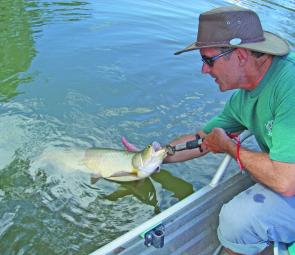
As we figured out how to fish from the boat, our success rate increased dramatically.
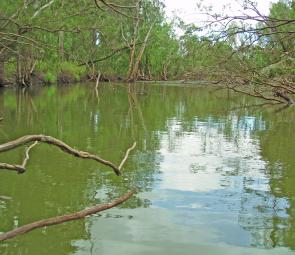
It would be very difficult to fly fish from the bank because of the vegetation, but a boat didn’t spook the togas at Connors, so that would be the way to go.
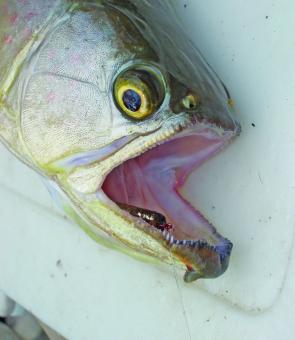
I was using a 10lb mono leader that proved no match for the togas’ saw-like teeth.
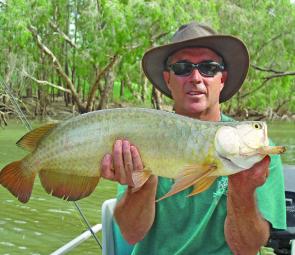
The thrill of catching saratoga rests with the sight fishing element in particular, but they also have a liking for leaping clear of the water in an attempt to dislodge the hook.

We ended up catching two togas over 70cm in length, but I saw plenty more in the river up to 80cm.
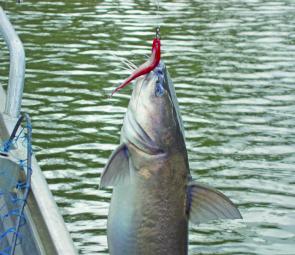
I’ve been told by more than one saratoga bait fisher that the best bait was a piece of steak. So my plan revolved around the colour red and plastic imitations.




